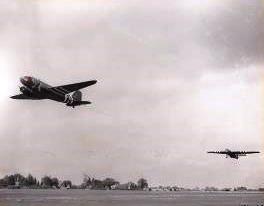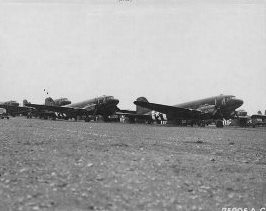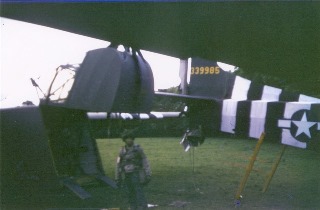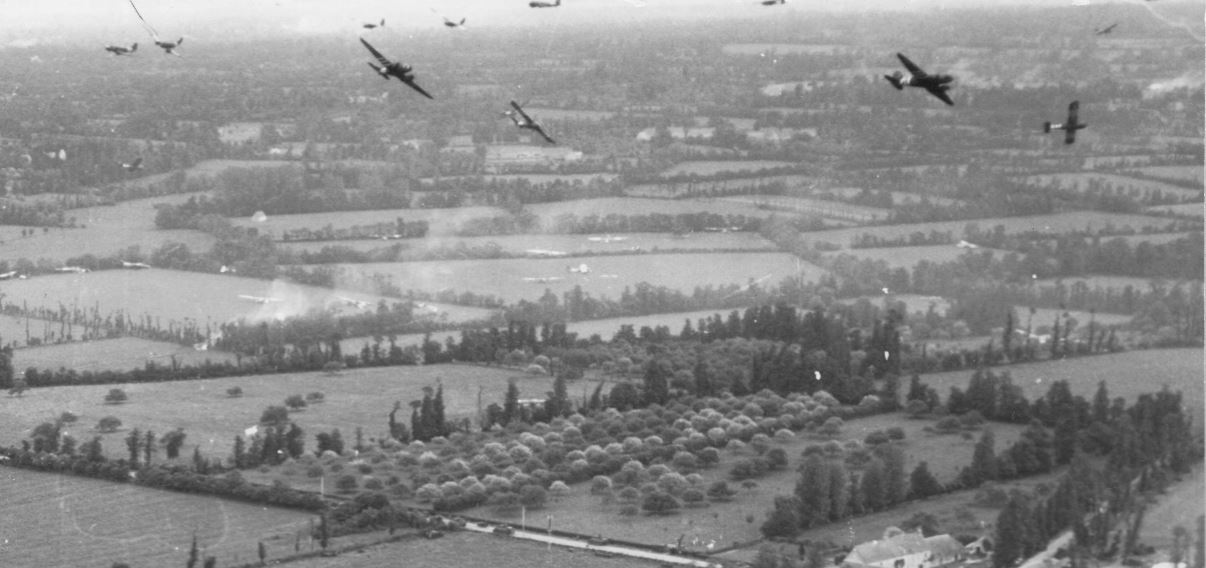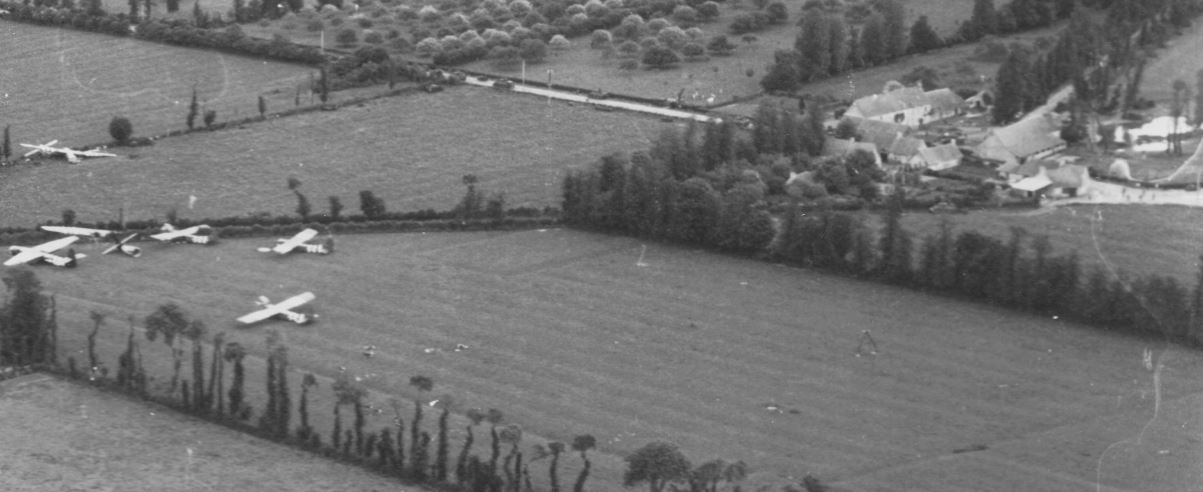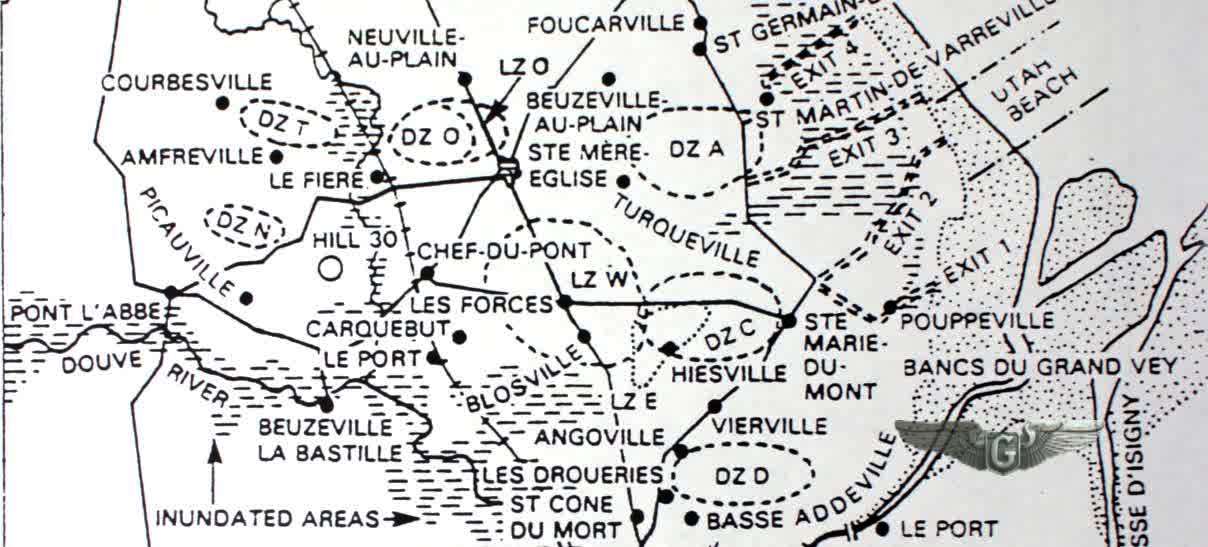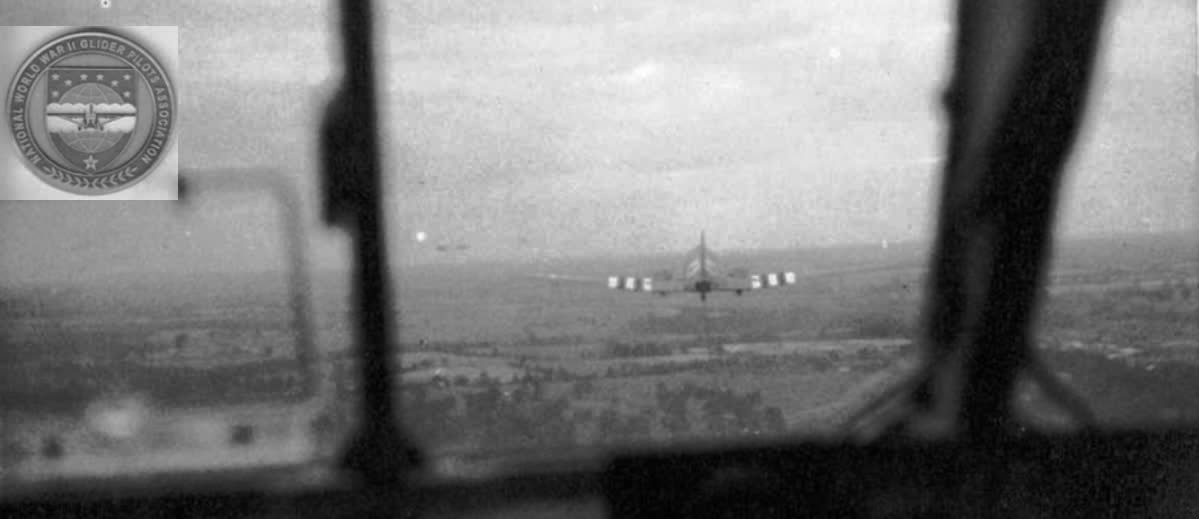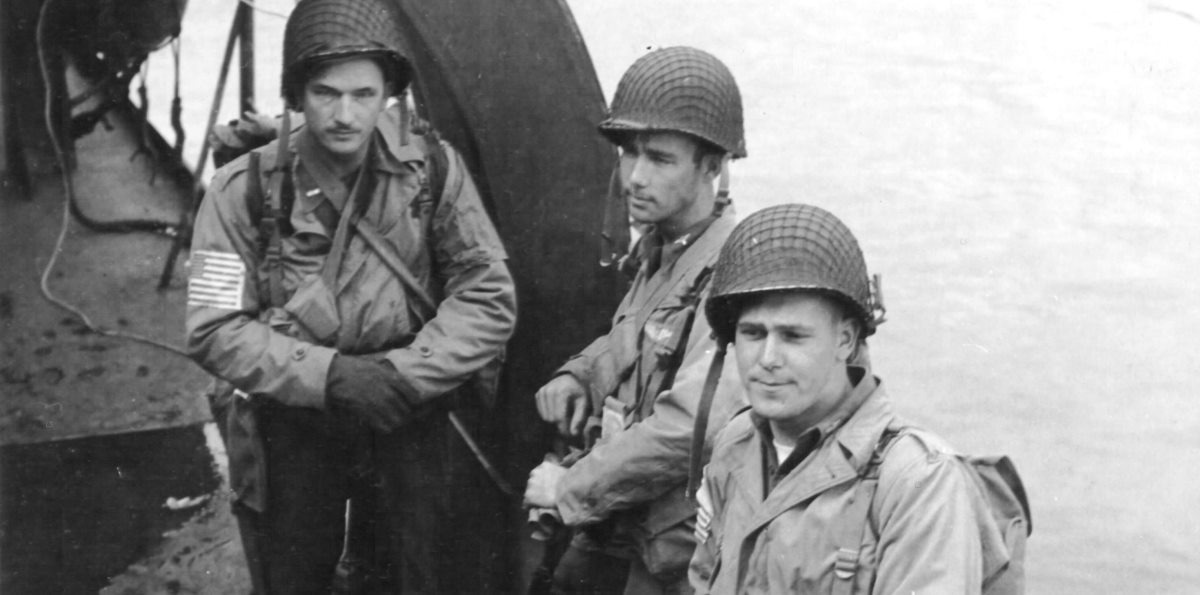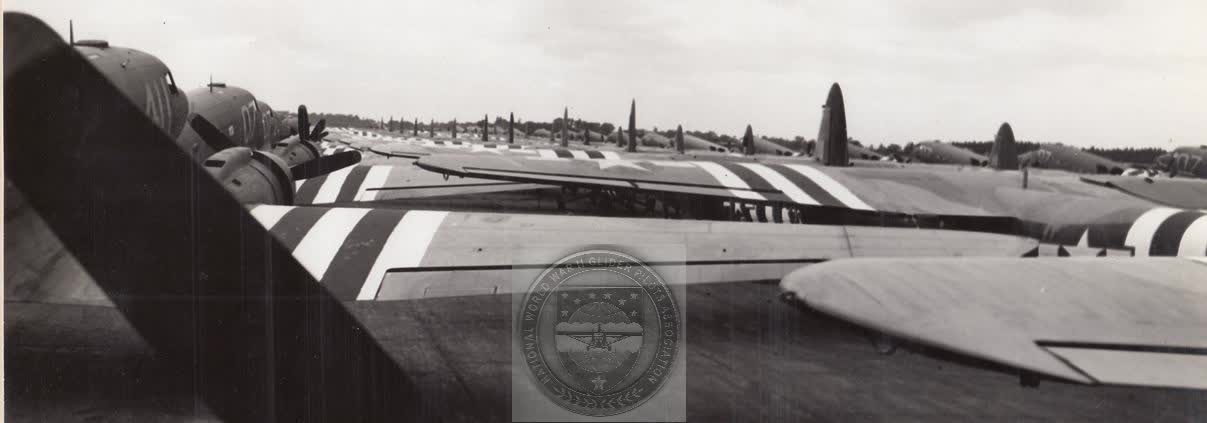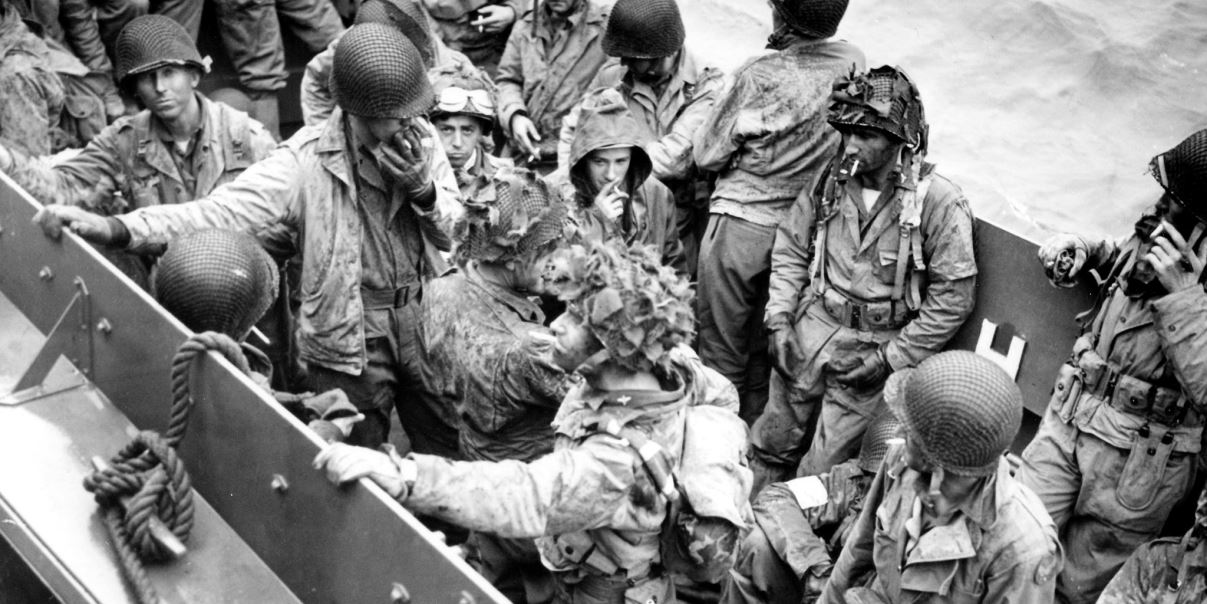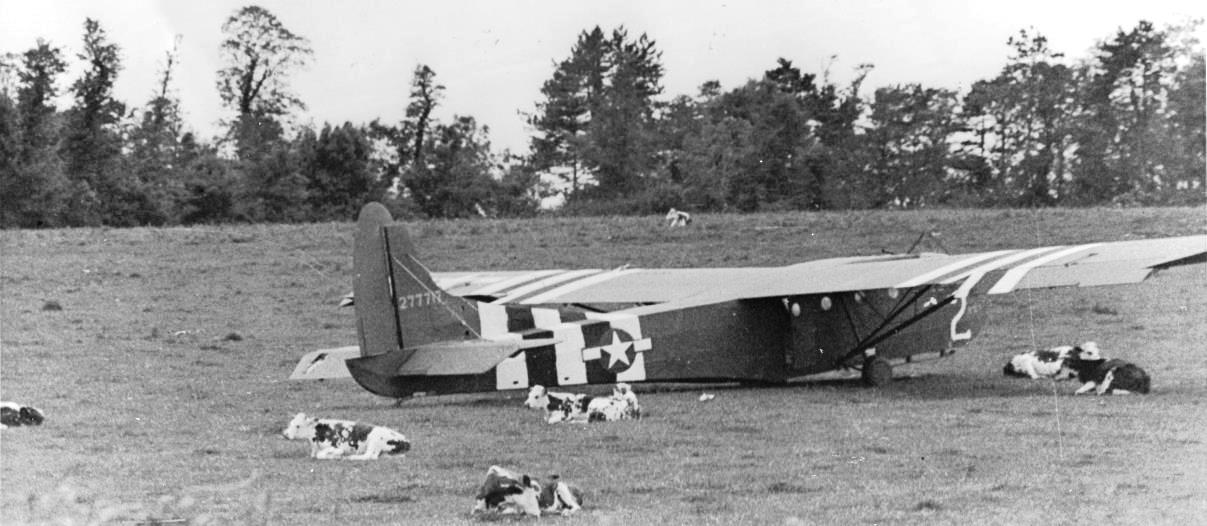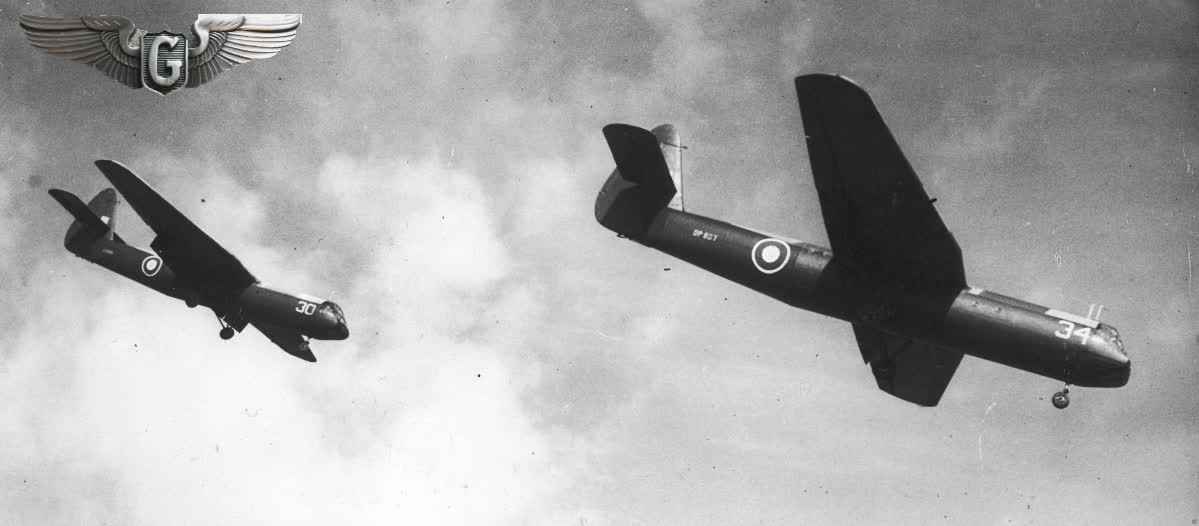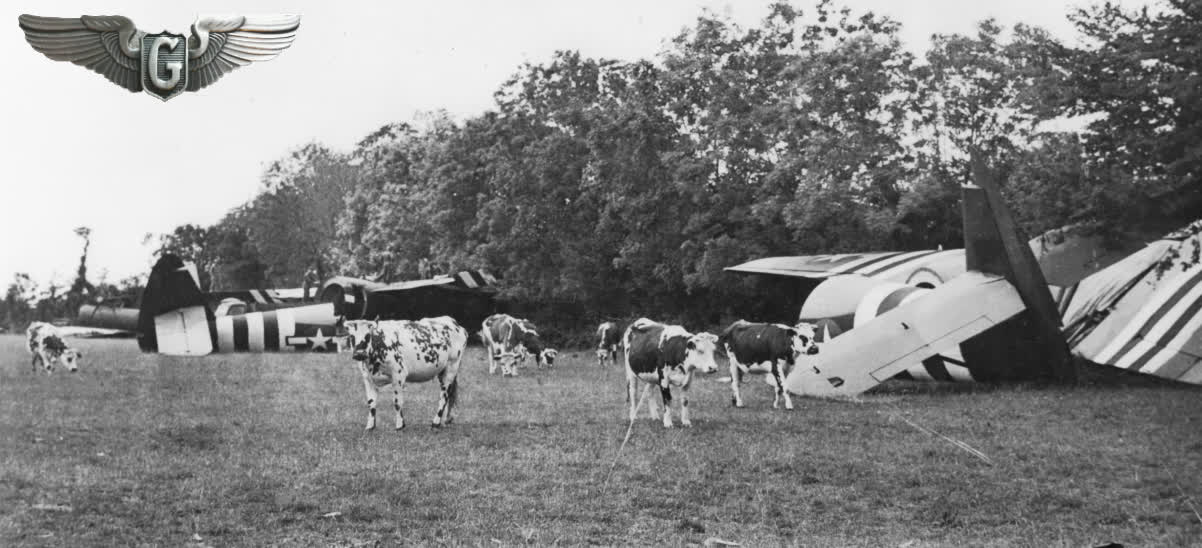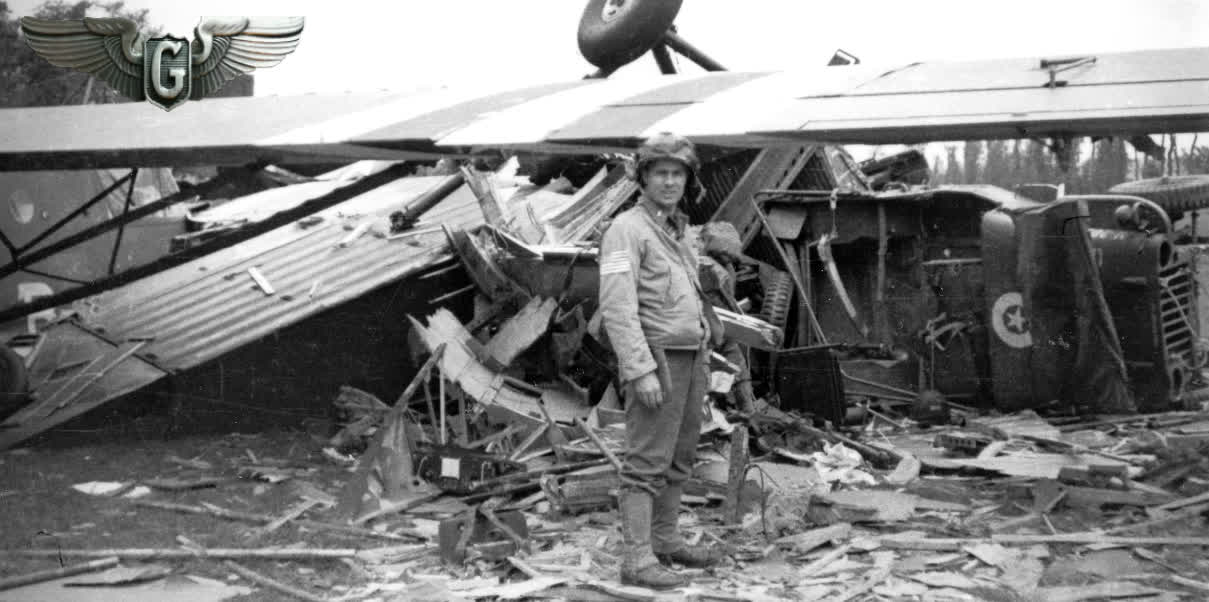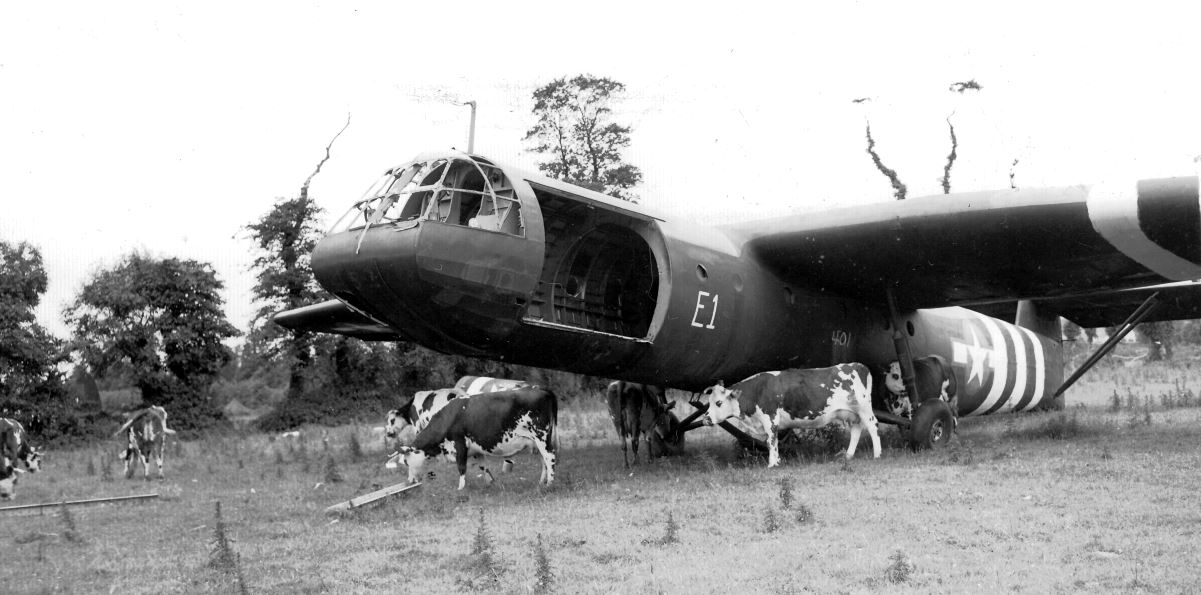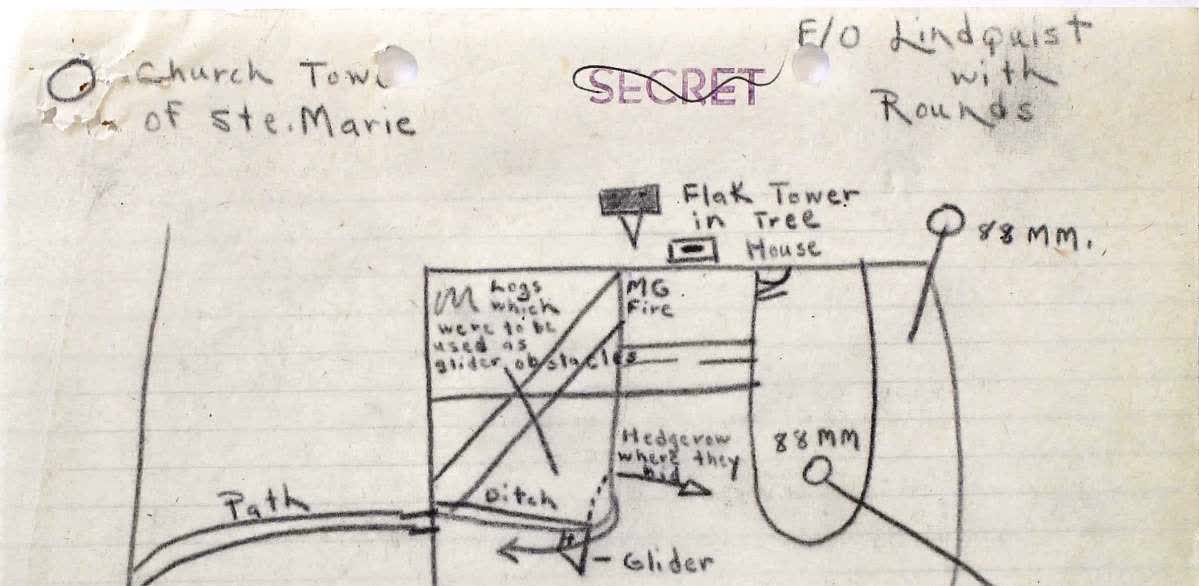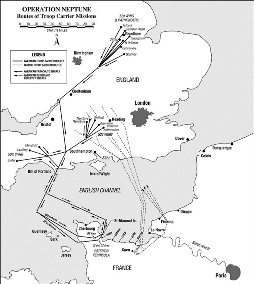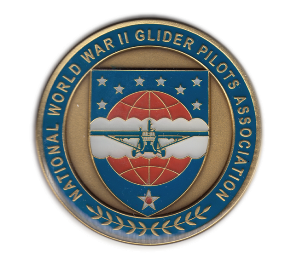|
88th TROOP CARRIER SQUADRON
438TH TROOP CARRIER GROUP
Greenham Commons
APO 133, US Army, 1 July 1944
SUBJECT: Historical Record of the 88th Troop Carrier Squadron
TO : Commanding General, IX Troop Carrier Command,
Att: Historical Section A-2
June 1943, the 88th Trooop Carrier Squadron was activated. Thirteen officers and fifteen enlisted men comprised the nucleous of the squadron that was to become a squadron of eighty-four officers and two hundred and sixty-eight enlisted men on year later. The growth of the squadron month by month has been recorded. Broadly speaking it has been a year devoted to preparing and training. It was therefore appropriate that with the completion of this year of activation, came paticipation in actual combat mission.
During the two day period of June fifth and sixth, this squadron flew two missions; the first a paratroop mission, the second a glider mission.
‘D’ day for the Allied forces had been a matter of great speculaton. The enemy, well aware of impending operations, could, it was assumed, only be surprised by the location and timing of the initial thrust. Therefore security precautions were of the utmost importance---security not only for a select few, but for all personnel, for any operations must be thoroughly rehearsed if it is to be successful.
The squadron was given a forty-eight hour period in which to conduct all its briefings. To facilitate in this and in security measures, the squadron's officers’ quarters were enclosed with barbed wire, guards were posted, a briefing room set up within the area, and all briefed personnel moved within the confines of this area. All functions that necessitated the leaving of the area, such as for messing purposes, were accomplished by marching in formation to and from the briefing area. Security within the squadron was accomplished.
Looking at the proposed operations in broad outline, the Allied Armies on ‘D’ day were to extablish a bridgehead on the Contentin Peninsula. The 101st Airborne division were to land by parachute and glider to assist the 4th Division oin the initial assault and capture of the town of Carentan. The 82 Airborne Division were scheduled to land by parachute and glider immediately west of the 101st Airborne Division to prevent the movement of enemy reserves east and north to bridgehead.
Specifically, the 88th troop carrier squadron as part of the 438th troop carrier group was committed on D minus one day, to fly second position, serial number eight, with eighteen C-47´s and crews, carrying units of the 502nd Parachute Infantry Battalion.
2000, 5 June 1944, the commanding officer announced that the mission which had been delayed twenty four hours to inclement wearher, would be flown on this night.
At 2030 the assistant crew chief of each aircraft reported to the group hangar to lead the airborne personnel of his plane to the plane in its parking area. The combat crew members reported to their planes at 2030 to supervise the loading and to check the load manifest lists. Paratroop officers read messages from General EISENHOWER to the men and clarified on last minute questions. BY 2200 all planes were loaded and ready for take off.
Major R. W. Gates commanding Officer, 88th T.C. Squadron, pilot of the lead ship, left the ground at 2250. The route flown was as briefed. [ref:Appendix A] The weather was marked by broken scattered clouds at fifteen hundred to three thousand feet with cloud base at 2500 feet. the full moon was intermittenly obscured by the clouds; visibility over the drop zone was approximately three miles.
On the route enemy flak was observed on the Guernsey and Jersey Islands, but too distant to describe in detail. Heavy flak was also observed but not encountered on the west coast of the Contentin Peninsula particularly at and around Cherbourg. As in the case in any troop carrier missions over enemy territory, small arms fire proved to be the greatest cause of concern. Small arms fire was first observed just to the south of the flight path about three to five miles inland from the western coast of the peninsula. From this point to the drop zone the fire was constant and inaccurate.
DZ ‘A’, parachute dropping zone for the 88th Troop Carrier Squadron was a field located in the southeastern part of the Cotentin Peninsula, approcximately two and a half miles from Ste. Marie Eglise (392978). Standard operating procedure for the jump was followed: twenty minutes out from the drop zone, the pilot gave a verbal warning to the jumpmaster; four minutes out, a red warning light; over the drop zone, a green light.
Three hundred and twelve troups of the 101st Airborne Infantry were dropped from the 88th’s eighteen planes at 0051, 6 June 1944, as well as nineteen thousand seven hundred thirty seven pounds of small arms, communication and medical equipment. All troops jumped over the center of the field from an altitude of seven houndred feet at the prescribed speed of one hudred and ten miles per hour.
The route from the drop one to greenham commons was accomplished without trouble. Small arms fire continued along the five mile route to the eastern coastline of the peninsula, but as was the case in the flight in, the fire proved to be inaccurate.
The corridor that was desingnated for the troop carrier aircraft over the English Channel and of the French bound Allied navel craft was stricktly adhered to. Past troop carrier missions had proven that was a prime necessity. Prescribed altitudes, and constant airspeeds were complied with, for it was no this basis that the rendezvous with the fighter cover was made possible and that friendly air ground & navel forces could accurately recognize troop carrier planes.
This mission, known as ‘Neptune-Bigot’, was outstanding from our standpoint, because it was run off so smoothly. Several navigational variations were the only difficulties encountered: at the point known as Austin, the occult flashed ‘H’ instead of ‘L’ (as was briefed); the occult at Elke flashed ‘D’ instead of ‘L’ (as was briefed); the occult at Elke flashed ‘D’ instead of ‘F’. ‘L’no balloon barrages were encountered and only two searchlights were seen over the port of Cherbourg.
The result of this first combat mission for the 88th was a complete success. All the troops were released at the pinpoint spot and evective surrise was attained. Eighteen aircraft took part in the mission and eighteen aircraft returned having performed the mission as ordered.
‘D’ day, 6 June 1944, the squadron flew its second combat mission. This was a glider mission for the landing of airborne troop of the 82nd Airborne Division in the southeastern part of the Cotentin Peninsula at a point know at GLZ ‘W’ located two miles southeast of Ste Marie Eglise (358930).
By 3 June the fouteen life rafts, eight one-fourth ten trucks, three motorcycles and trailer weighing a total of forty seven thousand forty seven pounds had been loaded into the fourteen GC-4A’s; breifings for the combat crew were completed by 5 June; protective clothing was unwrapped, the M-1 rifle zeroed for the last time. All equipment and personnel were in readiness for the take-off.
1849 hours, 6 June 1944, fourteen c-47’s left the Greenham Commons for the LZ ‘W’: The route followed was quite similar to that flown the previous night Ste Marie Eglise was appoached from the eastern side of the coast rather than the western. Over the landing zone and after the gliders had released, the tug planes made a hundred and eighty degree turn and retraced the flight plan used coming in.
The fighter escort joined our columns of planes at a point known as Salsy Bill. The first mission, our pilots reported that they had not seen the fighter escort, but this night, they reported squadrons of p-47’s, p-51’s, p-39’s at various heights. It was an encouraging sight. St. Marbeuf Island was passed with no enemy reaction, allied bombers and strafers had seen to that. The small arms fire began spasmodically over the eastern coast line and continued with greater force over the glider landing zone. Many pilots could identify light machine gun fire just to the right of the landing zone, located in the attic of a white house. Flak could be observed northwest of Ste Marie Eglise, but flak actually constituted no problem for troop carrier this mission.
All fourteen gliders of this squadron were released at approximately seven hundred feet over the LZ ‘W’. Pilots of the c-47’s observing landing of Horsa Gliders from previous serials noticed several gliders damaged upon landing. The principle reason for this seemed to be that the landing fields bordered by dense, tall trees were too small for proper landings. The larger fields that the glider pilots had been briefed to use were in a flooded condition. A number of gliders were burning probably due to tracer bullets used by the enemy. The jeep in one glider was seen to crash through the nose of the glider upon landing. Several pilots stated that they could see at least six gliders at one time that were cracked up. Results of our own glider landings could not be ascertained at this time.
On the return route, in the vacinity of Foucarville, plane 42-92894, was last seen feathering its right engine and rapidly losing altitude. It was evident that the pilot was in difficulty, but it could not be ascertained whether it was a result of mechanical failure or enemy fire.
Thirteen c-47’s returned to the bse at Greenham Commons, landing at 2310. A survey of the damage incurred, revealed one plane (42-100752) hit by enemy fire, the extent of the damage; one bullet throught the horizontal stabilizer, five through the fuselage and three bullets in the right wing.
Plane number 42-92894 was considered missing in action. The crew of this aircraft included; 2nd Lt. Samuel S. CROMIE, pilot, 2nd Lt. Floyd C. BENNETT, co-pilot; 2nd Lt Leonard L. BAER, navigator; S/Sgt. John G. HOLTON, crew chief; and Sgt. Joseph M. KOZIK, radio operator.
Mission number two was chalked up as a success, for the fourteen gliders with its load of twenty-nine troops of the 82nd Airborne, and its forty-nine thousand pounds of equipment were released at the proper glider landing zone.
8 June 1944, Lt. BAER and Sgt KOSIK, navigator adn radio operator of the missing aircraft reported back to the squadron area with their story. No difficulty was encountered until immediately after rolling out of the hundred and eighty degree turn. It was then the right engine was hit. Before the pilot had a chance to feather the first prop, the second engine was hit and the plane headed for a tree surrounded field. Swerving to avoid hitting the main grouping of tree, the wings and engines were torn off. The resultant crash threw Lt. BENNETT, co-pilot out of the plane. His was the only injury. After burning the ship and finding medical aid for BENNETT, the crew proceeded in pairs to the evacuation point and England. Lt. CROMIE and S/Sgt HOLTON reported the following day.
8 June 1944, nineteen very tired and unshaven glider pilots came to the interrrogation room to give the results of their part in the mission.
Briefly their stories were quite similar. All encountered small arms fire while in free flight and after the landing had been accomplished. Fields that they were briefed to land in were in the most part flooded. They were forced to choose postage stamp fields that were not apparantly under too heavy fire.
The first three gliders chose fields just south of Ecoqueneauvillie. Glider number one, piloted by 1st Lt Raymond E. DARLING and F/O William FORBELL was under constant fire by small arms fire and mortar fire. These men are now listed as missing. Glider number two landed a hundred yards away under the same conditions. F/O Robert L. CLEMENT pilot was killed by enemy machine-gun fire after the landing was made. Five enlisted men were also killed in this glider, only the copilot remained alive and that because he feigned death.
The eleven following gliders sensing the difficulties of the first three gliders landed further to the south. They too encountered enemy mortar and sniper fire but not of such a great intensity. The general practice was to hit the characteristic french ditch that surrounds each field, befor attempting to unload their equipment.
F.O Roderick DOYLE pilot of glider number eleven, died as a result of his glider crashing into the high trees. His co-pilot, F/O Frank L. COTROPIA had his left arm and leg broken as a result of this crash.
Of the twenty-eight glider pilots sent out on the mission seven were reported as casualties; two killed, two missing and three wounded.
The mission was successful from the standpoint of the equipment put into effective use. For all the equipment in the squadron’s gliders, with the exception of gliders number one and two were removed from the gliders and taken to the command post.
The question that has been constantly asked concerning the status of the glider pilot after hitting the ground was answered in full during this operation. The field order had stated that glider pilots landing in objective areas would come under control of the nearest ground unit. It further stated that evacuation of glider pilots from the continent to the United Kingdom would be of the highest priority.
For a twenty-four hour period these men worked hand in hand with the ground forces, acting as guards, snipers and actual infantry soldiers. From these experiences the glider pilots made these recommendations for future operations: All glider pilots be given an automatic weapon, perferably a machine gun, or at least a carbine to supplant the M-1 rifle; hand grenades should be supplied as these proved to be quite successful in forcing the enemy out of an entrenched position; glider pilots redezvous at a given point and act as an independent unit under their own commanders; radio contact from ground to glider, just before crossing LZ ‘W’ to give landing instructions and more accurate information on the enemy situation.
The main body of the glider pilots organized at a point near Ste Marie Du Pont during the afternoon of the 7 June for the four mile march back to the breach hear and evacuation on LST back to the United Kingdom.
The mission a was substantially successful, but the loss of life in several instances was unnecessary due to failure in landing in safer landing zones. On the whole the glider pilots fufilled their mission in spite of all obstacles and enemy opposition and effective use was made of better than eighty five percent of the glider borne troops and material.
On D plus five day, according to the field order, the 88th was to participate in its third combat mission. We were to provide fourteen C-47’s and fourteen Horsa Gliders to left elements of the British First Airborne division. Thirty new gilder pilots were brought in for this purpose. Nineteen on detached service and eleven assigned to the squadron.
The British Airborne had their gliders loaded and ready three days prior to the scheduled date. However, no further notice was submitted from 9th troop carrier and the mission was cancelled.
24 June 1944, three C-47’s from this squadron participated in a resupply and evacuation mission. The three plnes carried 16,210 pounds of ammunition to a landing strip known as E-1 located near St. Laurent Sur Mer. E-l is a landing strip running east and west approcimately three thousand feet long, made of dirt and gravel. Approach to the strip proved to be rather difficult due to the one-thousand foot long channel of ballons.
On the return trip, one plane evacuated sixteen litter cases landing ar Ramsbury, England. Two returned empty. the mission was unevetful and proved to be nothing more than a routine flight.
The second resupply and evacuatoin mission involving fifteen C-47 aircraft of this squadron was conducted the following day, 25 June 1944. The fifteen aircraft were divided into three serials of five aircraft, each serial carrying twent seven thousand, six hundred pounds of 105 howitzer ammunition.
This flight, too, for each of the three serials was uneventful. The weather was good, and visibility unlimited except for a one mile limit while flying over the English Channel. A squadron of P-47’s the fighter escort for this mission was picked up at Silsey Bill along the southern coast of England.
The landing was accomplished at landing strip A-6, located near Euzeville au-Plain, France. Here the ammunition was unloaded, and
litter cases loaded
on to the planes. Seven aircraft brought back seventy eight litter cases and forty-one walking cases to England. Because the airstrip was in constant use, and the paring area few, our planes could not wait more then an hour for evacuees. In some cases patients were not available for evacuation simply because their forms for transport were not complete. Seven planes retuned empty to Greenham Commons. One aircraft had a flat tire upon landing and did not return to England until the following day.
The mission was successful with a total of eight two thousand eight hundred pounts of ammunition safely delivered.
The squadron suffered a twenty-seven percent casualty loss among the gilder pilots as a result of the mission conducted on ‘D’ Day.
Twenty eight glider pilots were sent out from this squadron, of these, 1st Lt. Rayomond E. DARLING, 0673711, and F/O William H. FORBELL, Jr., T-1138 were reported as missing in action; F/O Robert L. CLEMENT, T-60717 and F/O Roderick DOYLE, T-121138, were killed in action; F/O Frank L. COTROPIA, T-121832 and F/O Herbert T. MULDER T-122498 and F/O Elmer W. WEEMS, T-121575, injured in action.
Twelve glider pilots from this squadron were placed on temporary duty with other troop carrier groups at the beginning of the month of June, of these ten were sent to the 435th T. C. Group and two the 437th.
These men participated in the glider mission over France on ‘D’ Day in much the same fashion as did our men. After their evacuation from the continent they were granted four day leaves before reporting back to the 88th.
Of this group of twelve, F/O Richard S. [MYERS], T-123428 and F/O Jimmy G. METCHICAS, T-122716 were reported killed in action, F/O Roderick M. MONISMITH, T-123422 and F/O Ernest F. VAN HOUTEN, T-124641, were injured in action.
The twelveth casualty of the squadron was 2nd Lt. C. BENNETT, injured as a result of a crash landing of a C-47 over France on ‘D’ Day.
Two days after the glider pilots return to the squadron, seven day leaves were granted to them. A system of leaves was set up so that each member ofa combat crew would receive a four day leave. It was so staggered that only one crew would be away from the base at a time. During the month seventeen officers and eighteen enlisted men left under this system.
Promotions for the month included sixty two enlisted men, and five officers. The five flying officers included Second Lieutenants, William B.BRYSON, John P. CALL, John B. CARR, Samuel S. CROMIE, and John C. WILKINSON, all promoted to First Lieutenants.
Administrative functions are still being hampered to a certain extent by the definite shortage of enlisted men that continues to exist.
The training of a year and the participation in at least six large maneuvers during that year, had taught the combat crews how to accept, and the importance of accepting briefings and interrogations. The groudn work of good habits along this line had been established.
To facilitate security measures and to provide adequate space for both maps and personnel, the Intelligence Section took over a Nisson hutment in the squadron area for briefing purposes. Because of its proximity to the living quarters the briefing room and the corresponding briefings proved to be very satisfactory. Pilots became more thoroughly familiar with their flight plans, duties and last minute changes by this proximity.
The Intelligince briefings, held by Capt. E. V. MALONEY, for the Neptune Bigot Missions were the vehicles for the pilots understanding of terrain features, known enemy installations, danger zones, and conduct of power pilots forced down. Every conceivable bit of information that might be needed was presented with the aid of maps, charts, stereo stips, and photographs. It was a well conceived, well planned and well breifed, mission.
Escape kits and purses were issued to all members of the combat crews before take-off to enemy territory. Lectures pertaining to escape and evasion and the use of these kits had been prsented on six occasions prior to the mission. Twenty two purses were lost as a result of mission number two, mostly by the glider ppilots. The loss seemed to be due in part to the manner in which they were carried. In spite of instructions to carry the puses on their persons many glider pilots found it more convenient to carry them in their musette bags or gas masks. Enemy activity upon landing casused many to leave personal equipment behind. A few glider pilots used the maps for orientation purposes after landing.
Interrogation for these missions proved to be successful, from the amount of informaiton gathered and from the attitiude of the crews toward the subject. The apathy that is sometimes apparant in practice maneuvers was supplanted by an eagerness that only actual combat conditions can give. In the light of htis enthusiasm and cooperation, the mission was a success from the Intelligence standpoint.
The briefing room after the first two missions, was held in reserve for any future operations that might have been ordered. This gave the Intelligence personnel ample space and locale to set up good maps of all war theaters, and to keep all movements especially the Normandy theater scrupulously charted and up-to date.
Lectures on the war’s developments and general strategy, on security and censorship violations, and on orientation and Army Talks; were stressed during this period. In collaboration with Major R. W. GATES, Commanding Officer and Capt. C. C. HASH, operations officers, Capt E. V. MALONEY summarized to the ground personnel of the squadron the briefing that had been given to the combat crews before the invasion missions.
Fundamentally, a summation of the Operations department for the month can best be recorded in terms of figures, hours and time. These operations, do represent to a certain extent, new phases in the work of the 88th Troop Carrier Squadron; it is therefore best to break the figures down numerically:
Thirty five service missions were flown for a total of eighty six hours and fifty-five minutes.Three hundred and twenty one training missions were conducted for a total of five hundred and thirteen hours and twenty minutes.Fifteen CG-4A’s and thirty-eight Horsa’s were towed by our C-47’s for a total of one hundred and seventy-tive hours and sixty five minutes.Three sub-operational missions netted a total of forty-seven flying hours.One combat mission for fourteen CG-4A’s for a total of thirty hours and fifteen minutes.Freight carried by our planes:Service Missions, six and a half tons carried.Sub-operational missions, fifty one and a half tons.Combat missions, thirty-three and one half tons.
On evacation missions, one hundred and forty-four litter and walking patients were returned to Great Britain.
Lectures were also scheduled by S-3 during the month in the following subjects; Sex morality, radar, Gee equipment, Log procedure, Astro Compass, Aircraft Recognition and Link Trainer.
The squadron supply complying with the requirements of the field order for the ‘Neptune Bigot’ Mission issued to the combat crews the following items. Two ‘K’ and one ‘D’ ration per crew member of each powered aircraft; one ‘K’ and two ‘D’ rations for each crew member of glider aicraft; one weeks gratuitous issue of cigarettes, tobacco, blades, matches and gum; seven full clips plus a hundred round for each sub-machine gun; five full clips plus fifty rounds for each carbine rifle; five full clips plus fifty rounds per each pistol. The field orders further stated that all combat crews would wear the herringbone twill protective clothing, and carry the full gas mask.
Heretofore, the squadron supply, has been stymied because of shortage of equipment. At the beginning of the month, Quartermaster team ‘B’ of this station came through with individual equipment that was so urgently needed at this time. ‘Neptune Bigot’inventory reveals that all organizatonal shortages of authorized equipment have been requisitioned.
During the monty of June, the Radar Department has been conducting experiments on using two radar beacons in conjuction with the plan’s instruments, for making blind landings. These proved to be successful, so that experiments on blind landings using one beacon are now contemplated as soon as the situation permits.
The command order of peaking the ‘Rebecca’ receiving frequncies had its origin in the 88th Troop Carrer Squadron. This was first started by peaking up on the frequency of the home beacon, giving our radar a greater range than the other squadrons were able to obtain, a report of this turned in to the 53rd Troop Carrier Wing. Other squadrons of the group followed our example and the results were so satisfactory that they also turned in like reports to Wing.
During the actual invasion missions there were no radar equipment failures on any ship of this squadron. Enemy small arms fire passed through a cable on ship number 42-100755 during the second mission. The lead plane on the first mission was unable to pick up the DZ beacon, but it has been established that the fault was not in the airborne equipment.
A new system of pre-flighting planes was devised during this month. A C-10 power plant was mounted on a trailer, each morning this was drawn up to the planes, plugged in, and radar equipment given a comple pre-flight. This system has paid dividents in time saved. Defective sets have been found which a less thorough pre-flight would never have brought to light.
16 June the radar advisor to General WILLIAMS Commanding General, Ninth Troop Carrier Command, came to Greenham commons for a meeting with Wing, Group and Squadron officers. The problems and results arising from the missions on D minus one day and D Day were discussed.
Lt. Ernest E. DUTCHER, [Ernie is a current member of the NWWIIGPA] head of the Radar Department has over the period of two months been conducting classes for combat crew in the various phases of radar. A ‘gee’ school for pilots and navigators was completed on 17 June.
A complete inventory of radar equipment was heald, after several trips to Neasdon and Bently Provy for spare parts, the department closed the month with a good record behind it.
In order that better communications might be facilitated 7 1/2 miles of telephone wire (W-1108) has been used, and twenty six inter-squadron telephones have been installed in the various departments. In addition two lines connect the squadron with the base. Under T/Sgt Maurice R.LEROY, the telephone repair men have repaired all open lines and shorts within the shortest possible time.
Teletype service is being maintained between squadron message centers, although there is a shortage of on teletype operator. Also in order to benefit by these TWX machines, they are being used for a B-fold purpose.
to received messages from various outside persons, or from squadrons, group or wing headquarters. Once received they are passed through our message center (with also was established during this month for the purpose of keeping correspondence properly addressed and filed for future refernece) then sent by courier to the proper addressee
our message center is the relay point for outgoing messages. Work is facilitated and time save. For instance the orderly room no longer must send a courier by jeep to hand in a report. Instead it is submitted to Lt. Rober A. DUBE’s message center, where it is then properly addressed and sent to its desitnation through channels.
The repair shop men should receive their share of the credit for the way they have worked and hours they have put in preparing for the invasion. Every ship’s radio installations were in tip top shape when the ships departed for France. Several nights the men worked until the early hours of the morning, and then reported for work at the regular time. Steps have been taken to improve the working conditions in the shop. Previously there was a shortage of space, but during their off-duty hours the men have built a new work bench which will enable them to move up radio repair efficiency to approximately 100%.
The doors have slides enabling the mechanics to have foothole space, and they can be slide into slots, thus leaving the bench open. Inside the bench is divided into sections. Each one has its shelves and slides. With this bench the mechanics are performing third and fourth echelon maitenance of all aircraft radio and radio installations. Ample space is provided for all repairs. Inside the bench are transformers to lower the voltage from the British system to the American. In short the two to one step up and/or step down transformers, relays, switches, batteries to provide 6,8,12,24 and 28 volt supply for different type of radio sets which require a special voltage.
On top of this bench are mock-ups, which can be briefly defined as: “Radios used for repairs on all aircraft radio equipment. They are an exact duplicate of all equipment in the plane.” “presently we have mock-ups for the 274n, receiver and transmitter, and 522 radio set. The benefits derived from this are many. Instead of working under cramped conditions in the plane, the men have space to work. Also the duplicate installation in the shop enable the mechanics to determine whether or not the trouble is in the radio or in the ship’s installations. A Scr-287 liaison equipment and SCR 269-G radio compass set will also be set up in the shop at a later date.
During this past month equipment was received to raise our equipment status to 92%. The message center received two MC-181-B stamp time clock, which enables us to stamp incoming and outgoing correspondence with the exact time and date that it passes through the message center.
The mechanics also received many spare parts needed to perform accurate maintenance on all aircraft radio equipment. Included was another 1e-19-B test set, which is used to tune the crystals of the SCR-522 British Command, high frequency radio set.
In preparation for the invasion missions all aircraft of the 88th were grounded to enable the engineering department to have all ships mechanically available for the mission. For identification purposes, zebra type markings were placed on each aircraft. Three alternating white and black strips on each wing and three toward the rear part of the fuselage.
From a mechanical standpoint the missions were successful. Enemy fire slightly damaged nine of our ships during the two missions. Two more ships were damaged to a greater extent; shells hit fuselage, wings and gas tanks. The majority of these enemy small arm shells seemed to be of the explosive type, made in three sections.
The required number of inspections were conducted throughout the month. One engine change was made on C-47 #42-100758, due to trouble in the internal right engine. Plane #42-68807 caught fire during a preflight check, due to electrical connections. The fire was put out quickly and only minor damage was incurred.
18 June, C-47 #42100887 on a routine glider pick-up flight, was damaged to a great extent. The damage was caused by a faulty break mechanism. The pick-up cable snapped and boomeranged back into the cabin, causing destruction within the main cabin and throwing debris everywhere. The cable tore the forward bulkhead out between the main cargo compartment and the crew compartment; the wench mechanism was a total loss. T/Sgt Delbert D KENDALL, 38069890, crew chief was slightly injured as a result of the flying debris. The 97th Service Team is now repairing the plane and replacing the new wench.
Plane #42-100757 lost right main wing fairing in flight due to the use of metal screws, which became loose during flight. It is believed that some kind of lock screw would prevent this. Plane #42-100752, landing on a short runway at Exeter, Wales, crashed and was damaged beyound repair. This made the second plane completely lost during the month.
During the process of checking out the glider pilots sent to us on detached service, the squadron”s two Horsa gliders were cracked up and wings torn off four CG4A”s as a result of two short landings.
Minor modifications were made during the month. Strap type litters were placed on all power ships and the electrical specialists have installed resin identification lights as prescribed by technical orders.
During the month, Lt. Robert OWENS, Engineering officer, has instituted a policy of round the table meeting for all enlisted men of his department. At this tinme problems relating to the departments work and difficulties were ironed out. It is proving to be a satisfactory method of handling existing and future problems.
Two men from the Engineering Department S/Sgt. John G. HOLTON, 14084030 and Sgt. James L. SLAUGHTER, 38314024, were sent to landing striip A-6, near Ste Marie Eglise, France, for duties in general maintenance work.
Several improvements in the work of Tech Supply were noted during the month of June: A new card index system was installed by Lt. Wiliam O. DYSART department head. This in conjuction with the newly instituted check up on follow ups of NIS (not in stock) proved to be quite a successful improvement. AOG (aircraft on ground) supplies not in stock, received the highest priority. If these supplies are not received during a forty-eight hour period the NIS is checked every two days. The URR (Urgent repair requirements) are checked every four days, if it is not received in the meantime. Under htis system the IOR (Immediate operations repair) is checked every seven days, and the regular NIS checked every ten days. Eoutine orders if not in stock usually take from ten days to two weeks throught routine channels. The OEL (Organization equipment list) shortages are being received in a regular fashion and it is expected in the near future to be completed.
The Personnel equipment’s work during the month of June was greatly increased in comparison to the previous months. The invasion caused a great demand from this department. Each crew member was supplied with parachutes, life rafts, life vest, flak equipment, oxygen masks and flares.
Although at the present time the personnel equipment department has the largest stock in its history, it is handicapped by the lack of repair equipment. The present stock includes seventy-five life rafts, five hundred parachutes, six hundred life vests, two hundred flak suits, two hundred oxygen masks, thirty dinghy radios, six-thousand flares and seventy-five B-4 emergency packs attached to each life raft.
During the invasion, personnel equipment was lost by both power and glider pilots. With the C-47 that crashed over France went five parachutes, five flak suite and helmets, five life vests and one life raft equipped with one dinghy radio. Twenty nine parachutes, twenty-nine flak suits and helmets, twenty nine life vests, were lost in the gliders.
The department is now operating in two buildings. One building is used for flotation work on the life rafts and vests, and for storage of equipment; the other is used as work shop for the drying and packing of parachutes.
Shortly after the first of the month the Squadron Softball Team won the Greenham Commons Softball Tournament and received a small placque from Ninth Troop Carrier Command denoting this. The base public relations officer was contacted and a photograph of the team was made. Stories of each member of the team are now being sent to their home town papers. Subsequentlly the 88th team was asked to replace the 53rd Wing Team in the ETO softball tournament.
During the month three additional “liberty runs” were made to see the popular Eighth Air Corps play “Skirts”. An additional Liberty run each Sunday afternoon has been approved, for the purpose of visiting historic and interesting towns in this vicinity.
Plans for the more active participation of squadron personnel through parties and intra-mural contests are now under the supervision of Sgt. Frederick W. GREENWALD, 37557727, Special Service NCO.
In all respects the squadron has bettered itself during this month of June. The key to this situation can probably be attributed to the enthusiasm and cooperation that can only be present when actual combat participation is experienced.
Philip E. Pierson
PHILIP E. PIERSON,
2nd Lt. Air Corps,
Historical Officer
[AFHRA IRISREF A0993 June 1944 narative/NWWIIGPA collection]
|
